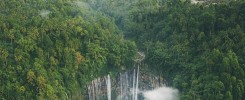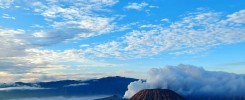MOUNT IJEN CRATER
Mount Ijen is a volcano located on the border between Banyuwangi Regency and Bondowoso Regency, East Java, Indonesia. This mountain has an altitude of 2,386 meters above sea level and is located adjacent to Mount Merapi. Mount Ijen last erupted in 1999. One of the most famous natural phenomena of Mount Ijen is the blue fire inside the crater located at its peak. This mountain climbing can be started from two places. Climbers can depart from Banyuwangi or from Bondowoso.
IJEN CRATER
Ijen Crater is acidic Crater Lake located at the top of Mount Ijen with a lake depth of 200 meters and the area of the crater reaching 5,466 hectares. Ijen Crater Lake is known as the largest strong acid water lake in the world. Ijen Crater is in the area of Ijen Tourism Park Bondowoso Regency and Banyuwangi Regency, East Java. The phenomenon of eternal blue fire is in the crater of Ijen, and this natural scene only occurs in two places in the world, Iceland and Ijen. Blue fire can only be seen by the human eye when there is no light, so the ideal time to see it is from 2 to 4 in the morning, because the climb of Mount Ijen begins to open at 2 in the morning. From the Ijen Crater, we can see views of other mountains in the Ijen Mountains complex, among which are the summit of Mount Merapi located east of Ijen Crater, Mount Raung, Mount Suket, and Mount Rante.
This most beautiful place is in Mount Ijen. Mountain has name throughout the Banyuwangi region. Interestingly again, Ijen Crater is a place for one of the international events that are held almost every year. The event was Tour De Ijen. Many participants from abroad took part in this annual cycling event. Therefore, this area has a very smooth and soft road that is different from the roads around other mountains that are still less friendly. To go up to the crater of Ijen must use a special mask because of the very strong sulfur odor present between climbing trips. This sulfur is the forerunner of the formation of blue fire. Sulfur combines with the crater with the highest levels of acid and oxygen to form a very beautiful scene. This view only exists at midnight until before Fajr approaches.
BLUE FIRE
Ijen Crater is indeed famous for its blue fire. This is the reason many tourists visit this region. The sunrise spot and the blue fire spot are indeed different. Blue Fire Spot is a little far from the sunrise spot, because this spot is near the crater. So, you have to go down this crater first. Be careful to go down this crater, and it is recommended not to enjoy it too long. Given the smell of sulfur that is very strong and pungent. You might native friend faint because of this pungent odor. Once satisfied with this spot, you can enjoy a very interesting sunrise spot. From this crater the native friend has to go up a little bit up to the sunrise spot. The best time to go to this region is November to January, and April to May. Where this area has a very beautiful and enchanting sunrise view. Therefore, Banyuwangi is called Sunrise of Java.

